We are all more familiar with the terms SUM and PRODUCT in mathematics. Based on these terms, AND and OR logical operations are derived. Any kind of logical expression can be represented through these terms and there are many ways of expressing a logical function. AND represents the product relationship between the terms whereas OR represents sum relationship. So, Sum of Products and Product of Sums are the equivalent approaches of representing a logical expression. Through few principles, these two forms are interchangeable and let’s go with a clear discussion on what is POS and SOP?
What is Called Sum of Products?
The Sum of Products is abbreviated as SOP. It is the logical expression in Boolean algebra where all the input terms are PRODUCTed first and then summed together. Here the product in Boolean algebra is the logical AND, and the sum is the logical OR. To be clearer in the concept of SOP, we need to know how a minterm operates.
Min Term
So, the term SOP is also defined as the expression which is completely of minterms. The word minterm holds true for a minimal number of combinations of input terms. As the output of AND gate is only true when all the input terms are in logic ‘1’, so minterms are the logical ‘AND’ of input combinations. The below table clearly describes the concept of minterms.
An SOP is even stated as Disjunctive Normal Form As because all the product terms are added together through logic OR.
|
X |
Y |
Z | Min Term |
| L | L | L |
y0 = X’Y’Z’ |
|
L |
L |
H | y1 = X’Y’Z |
| L | H | L |
y2 = X’YZ’ |
|
L |
H |
H | y3 = X’YZ |
| H | L | L |
y4 = XY’Z’ |
|
H |
L |
H | y5 = XY’Z |
| H | H | L |
y6 = XYZ’ |
| H | H | H |
y7 = XYZ |
Types of Sum of Products
To express the logical expression in SOP format there are mainly three types and those are of:
- Canonical SOP
- Non-Canonical SOP
- Minimal SOP
Canonical Sum of Products
This is also called a standard SOP form. Here, all the minterms for which the outputs are true are ORed. So, SOP is defined as Sum of Its Min Terms or the other name is Canonical Disjunctive Normal Form. So, this is represented by the sign Σ and all the minterms are enclosed in brackets.
Let’s have a clear interpretation with the below example
|
X |
Y | Z |
F |
|
L |
L | L | L -y0 |
| L | L | H |
H – y1 |
| L |
H |
L | H – y2 |
| L | H | H |
H – y3 |
|
H |
L | L | L – y4 |
| H | L | H |
H – y5 |
|
H |
H |
L | L – y6 |
| H | H | H |
L – y7 |
So, the canonical SOP is represented as
F = Σ (y1, y2, y3, y5)
As the sign (‘Σ’) is the representation for summation. The F is
F = y1 + y2 + y3 + y5
In the expression of minterms, F = X’Y’Z + X’YZ’ + X’YZ + XY’Z
Non-canonical Sum of Products
The name itself indicates that this is the non-standardized form of SOP. The simplified minterms are PRODUCTed and then the result is ORed.
The above example in the non-canonical SOP is represented as follows:
F = X’Y’Z + X’YZ’ + X’YZ + XY’Z
F = X’Y’Z + X’Y (Z’ + Z) + XY’Z
F = X’Y’Z + X’Y (1) + XY’Z
F = X’Y’Z + X’Y + XY’Z
So, the expression F is in the SOP form, but in a non-canonical form.
Minimal Sum of Products Form
Here also the name itself indicates that the expression is a very simplified one. Minimal SOP expression can be developed through Boolean theorems whereas the simplification of the expression will be easily done through K-map.
In many of the situations, minimal SOP form is implemented because of its minimal size, reduced development cost makes use of the minimum number of gates and inputs and also quick speed.
The expression stated above can be represented in minimal SOP form as follows:
As the output is true for y1, y2, y3, and y5, through K-map, the output is exemplified as
F = Y’Z + X’Z
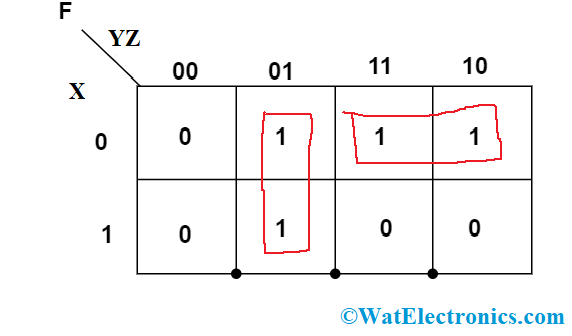
minimal SOP
So, the main benefit of minimal SOP form is it requires only 2 AND gates and one OR gate rather than 3 AND gates and 1 OR gate.
These are three types of SOP expression redundant forms.
Schematic Design of Sum of Products
SOP form is implemented using AND-OR gates where it is the group of AND gates and one OR gate. The design is that all the input terms are PRODUCTed and the resultant outputs are then ORed. Based on the logical expression, the circuit goes with a number of AND and OR gates. The below diagrams represent the schematic diagrams of SOP in canonical and minimal forms.
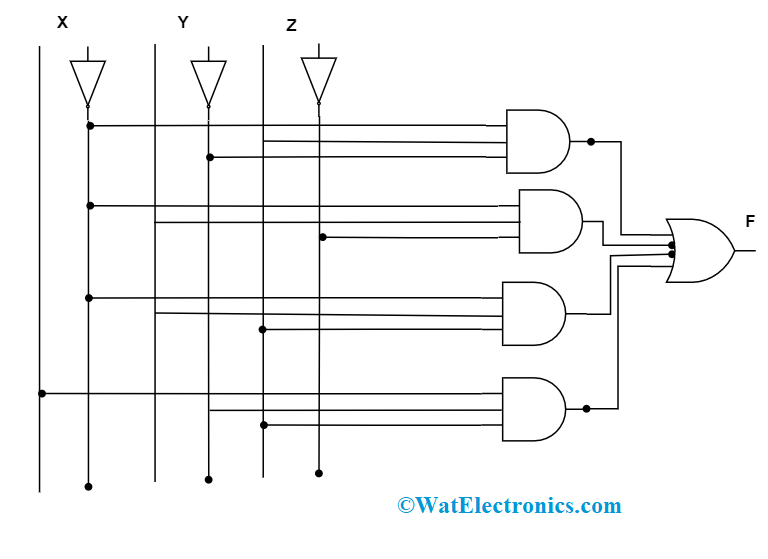
schematic canonical form SOP
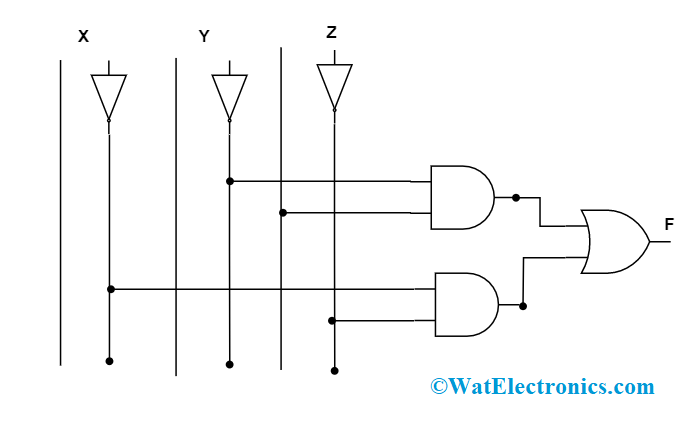
schematic minimal form SOP
What are called Product of Sums?
Product of Sums is abbreviated a POS. It is the logical expression in Boolean algebra where all the input terms are ORed first and the results are PRODUCTed. The summing operation is not the arithmetic or sum, but it is the logical OR operation. As this is the reverse operation for what SOP is performed, it is even termed as Dual of SOP. The other name for POS is the Conjunctive Normal form where logical AND is performed.
Max Term
So, the term SOP is also defined as the expression which is complete of max terms. The word maxterm holds true for a maximum number of combinations of input terms or even defined as false for only one input combination. The below table clearly describes the concept of max terms.
|
X |
Y | Z |
Max term |
|
L |
L |
L | A0 = X+Y+Z |
| L | L | H |
A1 = X+Y+Z’ |
|
L |
H |
L | A2 = X+Y’+Z |
| L | H | H |
A3 = X+Y’+Z |
|
H |
L | L | A4 = X’+Y+Z |
| H | L | H |
A5 = X’+Y+Z’ |
|
H |
H | L | A6 = X’+Y’+Z |
| H | H | H |
A7 = X’+Y’+Z’ |
Even the outputs of POS are represented as a complement of SOP outputs. For example:
A3 = (y3)’ = (X’YZ)’
= X + Y’ + Z (By Demorgan’s Law)
Types of Product of Sums
To express the logical expression in POS format there are mainly three types and those are of:
- Canonical POS
- Non-Canonical POS
- Minimal POS
Canonical Product of Sums
This is also called a standard POS form. Here, all the outputs for which the output is false are PRODUCTed. So, POS is defined as Product of its max terms or the other name is Canonical Conjunctive Normal Form. So, this is represented by the sign Π and all the max terms are enclosed in brackets.
Let’s have a clear interpretation with the below example
|
X |
Y | Z |
F |
|
L |
L | L | L – Y0 |
| L | L | H |
H – Y1 |
|
L |
H | L |
H – Y2 |
| L | H | H |
H – Y3 |
|
H |
L | L | L – Y4 |
| H | L | H |
H – Y5 |
|
H |
H | L | L – Y6 |
| H | H | H |
L –Y7 |
So, F = Π (Y0, Y4, Y6, Y7) or Y0.Y4.Y6.Y7
Expanding the terms F = (X+Y+Z) (X’+Y+Z) (X’+Y’+Z) (X’+Y’+Z’)
Non-Canonical Product of Sums
The name itself indicates that this is the non-standardized form of POS.
The above example in non-canonical POS is represented as follows:
F = (X+Y+Z) (X’+Y+Z) (X’+Y’+Z) (X’+Y’+Z’)
F = (Y+Z) (X’+Y’+Z) (X’+Y’+Z’)
And the final minimized expression in non-canonical form is
F = B +C
Minimal Product of Sums
Here also the name itself indicates that the expression is a very simplified one. Minimal POS expression can be developed through Boolean theorems whereas the simplification of the expression will be easily done through K-map.
In many of the situations, minimal POS form is implemented because of its minimal size, reduced development cost makes use of a minimum number of gates and inputs and also quick speed.
The expression stated above can be represented in minimal SOP form as follows:
Through K-map, the output is exemplified as
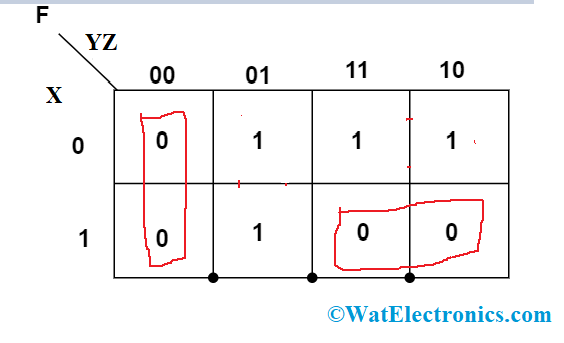
minimal POS
F = (Y+Z)(X’ + Y’)
So, the main benefit of minimal POS form is it requires only 2 OR gates and one AND gate rather than 4 OR gates and 1 AND gate.
These are three types of POS expression redundant forms.
Schematic Design of Product of Sum
POS form is implemented using OR-AND gates where it is the group of OR gates and one OND gate. The design is that all the input terms are ORed and the resultant outputs are then PRODUCTed. Based on the logical expression, the circuit goes with a number of OR and AND gates. The below diagram represents the schematic diagram of POS canonical and minimal forms..
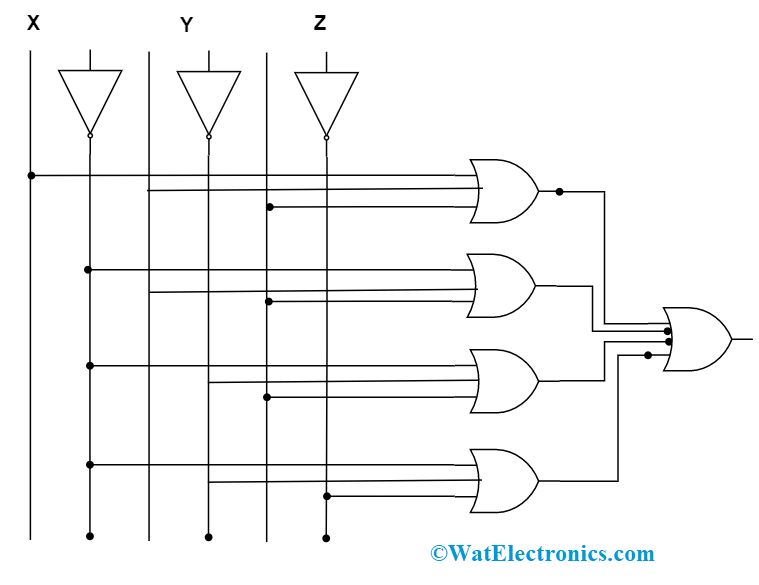
schematic canonical POS
The below diagram represents the schematic diagram of POS minimal forms.
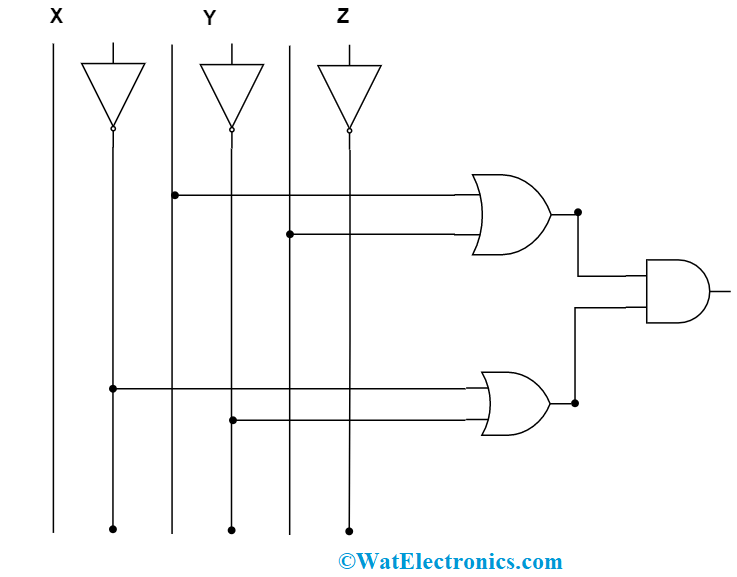
schematic minimal POS
Canonical SOP to Canonical POS
Along with these, let’s go with the discussion of conversion from canonical SOP to canonical POS. The SOP expression is
F = X’Y’Z + X’YZ’ + X’YZ + XY’Z
F = Σ (y1, y2, y3, y5)
The remaining terms in the expression are called max terms and those are A0, A4, A6, and A7. Max terms are represented in POS form and represented as
F = Π (Y0, Y4, Y6, Y7)
F = (X+Y+Z) (X’+Y+Z) (X’+Y’+Z) (X’+Y’+Z’)
Canonical POS to Canonical SOP
The POS form can be converted only when the expression is in canonical form. Canonical POS and SOP expression can be interchanged. For example, the POS canonical expression is
F = (X+Y+Z) (X’+Y+Z) (X’+Y’+Z) (X’+Y’+Z’)
F = Π (Y0, Y4, Y6, Y7)
The remaining terms in the expression are called max terms and those are A0, A4, A6, and A7. Max terms are represented in POS form and represented as
F = Σ (y1, y2, y3, y5)
F = X’Y’Z + X’YZ’ + X’YZ + XY’Z
FAQs
1. How do you convert the product of sums to the sum of products?
The SOP expressions can be converted to POS expression through complement. Where product term expressions are converted to sum term expressions. XY+YZ is converted as (X+Y) (Y+Z).
2. What is the sum of product form?
It is the Boolean logical expression where the input terms are PRODUCTed and the results are ORed.
3. What is the difference between the sum of product SOP and product of sum POS?
The difference between the two expressions lies in the product and sum of their inputs. These two are a complement to each other where logical AND in one form is represented as logical OR and vice-versa.
4. What is SOP expression?
SOP expression is the Boolean algebraic expression which is derived through minterms.
5. What is the standard SOP form?
In the standard SOP, every product term might not contain all the literals. So, it is termed as a canonical form in the SOP format.
As because of the wide range of advantages in these SOP and POS forms, they are mostly implemented in many of the logical circuit derivations. Know what are the more conversions and examples of Sum of Products and Product of Sums forms?